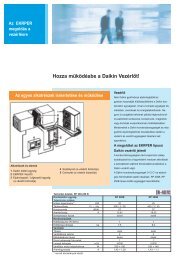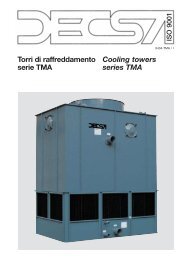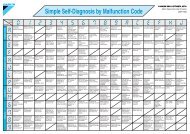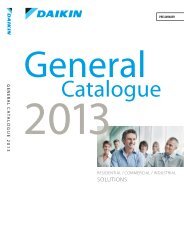1. D-BACS - Daikin
1. D-BACS - Daikin
1. D-BACS - Daikin
You also want an ePaper? Increase the reach of your titles
YUMPU automatically turns print PDFs into web optimized ePapers that Google loves.
Introduction<br />
Term Explanation<br />
D-<strong>BACS</strong> It stands for <strong>Daikin</strong> Building Air-conditioning Control System.<br />
Means centralized air-conditioning management and control system based on highly expandable DAIKIN<br />
original network communication technology, DIII-NET. It is DAIKIN products that can be mainly controlled<br />
through DIII-NET on D-<strong>BACS</strong>. And with various expander adapters connected , functions and usage of<br />
control system can be expanded for following 3 sections of devices : 1) Equipment (electricity, plumbing,<br />
elevator, ventilation, fire alarm, lighting, car park and crime/disaster prevention panel), 2) meters (electricity,<br />
gas and water supply) and 3) environmental monitoring sensors (temperature, pressure, humidity and<br />
voltage/current).<br />
Di Unit Device by which DAIKIN centralized controllers are able to monitor operation and malfunction of up to 8<br />
individual building facility equipment through DIII-NET, and pass them to centralized controllers. 'I' in Di<br />
stands for INPUT from building facility equipment, and Di unit is only able to receive INPUT signal from<br />
equipment, while Dio unit can receive operation signals from centralized controllers, and dictribute OUTOUT<br />
signals to individual building equipment.<br />
Dio Unit Device that is able to control operation, and monitor operation and malfunction for building equipment. 'I' in<br />
Dio stands for INOUT from building facilities, while 'o' stands for OUTOUT to building facilities. This means<br />
Dio unit can control building facility equipment for both ON and OFF operation. Di unit can only monitor ON<br />
and OFF operation from building facility equipment.<br />
DIII-NET Refers to <strong>Daikin</strong> Industries original communication network for A/C communications. (closed network)<br />
Echelon The U.S. company that developed the LON.<br />
Ethernet Refers to the name of and standard pertaining to a LAN product developed by Xerox.<br />
Jointly developed by Xerox, DEC and Intel in 1980, Ethernet is the LAN used within BASs.<br />
Free Topology Refers to a branched free-type connection arrangement within a network.<br />
<strong>Daikin</strong>'s Interface for LONWORKS ® only supports free topology.<br />
Gateway Refers to a device that translates the different communication codes sent between central monitoring panels<br />
and A/C units to enable mutual communication.<br />
It is used when more than one network is connected.<br />
Interface for LONWORKS ® and the Master Station are two such examples.<br />
General Refers to the term 'general' used when conducting general or batch control. When controlling an entire<br />
system, control is not conducted on each particular A/C unit, but on a generalized basis (all of the A/C units<br />
together).<br />
Group System of up to 16 indoor units controlled simultaneously from single or double remote controllers.<br />
Heartbeat Refers to a function that cyclically communicates values of specific network variables.<br />
Even if a main monitoring node does not request the data (does not confirm the status of the A/C unit), the<br />
machine itself will automatically send the values. It allows the user to conclude that the node is operating<br />
normally while this value is being sent.<br />
HIM Human Interface Module<br />
A device that incorporates the concept of the standard BAS protocol supported by the Institute of Electrical<br />
Installation Engineers of Japan (IEIEJ). It enables the setting of parameters for status display, control and<br />
monitoring of building equipment. It refers to a human interface device that performs On/Off operations and<br />
the like.<br />
Icont Intelligent Controller<br />
A device that incorporates the concept of the standard BAS protocol supported by the IEIEJ. It is a control<br />
device that is connected to either the building equipment or devices targeted for control via an interface. It<br />
refers to a device that can support functions of independent monitoring, control and the like.<br />
IEIEJ Institute of Electrical Installation Engineers of Japan<br />
xii <strong>1.</strong>5 Open Network Glossary







